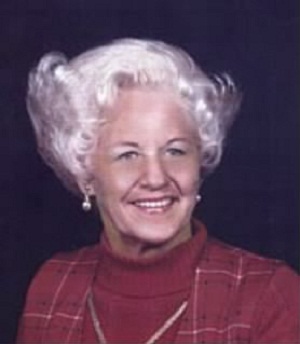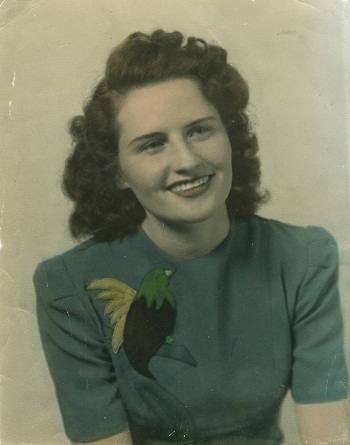"Our Rosie the Riveters"


This story is about "Our" Rosie the Riveter but has a slightly different twist to the tale. It is a tale of two sisters who were born in Pulaski County, Kentucky. Clara Rose Lay and her sister, Eula Lay were two daughters in a fairly large family of seven daughters, two sons and their parents, Walter Green Lay and Minnie Alice Calder. Rose was born on 2 March 1920 at Bobtown near Somerset and Eula was born on 29 November 1918 in Norwood near Science Hill. Both were energetic family oriented young women but at the same time very independent, fiesty, and tomboys! The above photograph was taken during the late teen years for Rose (on the left) and Eula (on the right.)
 Rose married Clarence Abbott which produced two children Connie, born 1937,and Troy Abbot, born 1940 .
Clarence was killed in an accident during 1943 while riding on the running board of a car when it was struck by a bus.
Rose and her two young children left Kentucky and traveled north, to Michigan in an effort to support her children.
She found employment at the the Willow Run factory near Detroit which produced aircraft.
This factory also trained female pilots to fly armaments around the country, and she hoped to be chosen for this program.
However, because she was a single mother, she was not selected, and so her career consisted of assembling planes, rather than flying them.
Back in Kentucky, Eula had married Edward Carl Robert Lee Mize, who was named for all of his uncles but was affectionately
known as Robert Lee Mize.
Robert Lee was the son of Eddie Fulton Mize who lived in Science Hill and worked
at the Telephone Exchange as an operator; he was also a skilled gunsmith and watch repairer.
Soon after their marriage, Robert Lee and Eula moved onto the farm of his grandpa, Jack Mize, and lived in the upstairs room
of the farmstead.
Jack asked the neighbors to pitch in and build the newlywed couple a cabin on the farm
which promptly began, and was finished soon thereafter.
The two room cabin was enough for a starter home but soon the freshly married couple
wanted more and when Eula's sister, Rose, told them of employment opportunities at the Willow Run Aircraft Factory
in Michigan,
they jumped at the opportunity and quickly moved from their cabin in southeastern Kentucky to an
apartment near the plant in Ypsalanti, Michigan.
Rose had been working as a riveter on B-24 Liberator and B-29 Superfortress bomber planes for the U.S. Army Air
Force; Eula was
furnished with a metal bucking bar and they were both became working full time employees for the war effort.
Rose worked on the outside of the aluminum aircraft skin riveting and Eula working on the
inside of the fuselage completing the riveting process with her bucking bar.
Rose married Clarence Abbott which produced two children Connie, born 1937,and Troy Abbot, born 1940 .
Clarence was killed in an accident during 1943 while riding on the running board of a car when it was struck by a bus.
Rose and her two young children left Kentucky and traveled north, to Michigan in an effort to support her children.
She found employment at the the Willow Run factory near Detroit which produced aircraft.
This factory also trained female pilots to fly armaments around the country, and she hoped to be chosen for this program.
However, because she was a single mother, she was not selected, and so her career consisted of assembling planes, rather than flying them.
Back in Kentucky, Eula had married Edward Carl Robert Lee Mize, who was named for all of his uncles but was affectionately
known as Robert Lee Mize.
Robert Lee was the son of Eddie Fulton Mize who lived in Science Hill and worked
at the Telephone Exchange as an operator; he was also a skilled gunsmith and watch repairer.
Soon after their marriage, Robert Lee and Eula moved onto the farm of his grandpa, Jack Mize, and lived in the upstairs room
of the farmstead.
Jack asked the neighbors to pitch in and build the newlywed couple a cabin on the farm
which promptly began, and was finished soon thereafter.
The two room cabin was enough for a starter home but soon the freshly married couple
wanted more and when Eula's sister, Rose, told them of employment opportunities at the Willow Run Aircraft Factory
in Michigan,
they jumped at the opportunity and quickly moved from their cabin in southeastern Kentucky to an
apartment near the plant in Ypsalanti, Michigan.
Rose had been working as a riveter on B-24 Liberator and B-29 Superfortress bomber planes for the U.S. Army Air
Force; Eula was
furnished with a metal bucking bar and they were both became working full time employees for the war effort.
Rose worked on the outside of the aluminum aircraft skin riveting and Eula working on the
inside of the fuselage completing the riveting process with her bucking bar.
To see the Willow Run Aircraft Factory history click on HISTORY OF WILLOW RUN . This link will take you to youtube.com and when you are done just hit the backspace key to return here!
 Both were contributing to the war effort and were
working jobs which had been traditionally men dominated jobs.
During their employment at the plant, the Canadian actor, Walter Pidgeon,
toured the facility for a War Bond drive and he was told that they employed a riveter who was named Rose.
This was coincidentally the same time which the
popular song, "Rosie the Riveter" written by Redd Evans and John Jacob Loeb and was released to
the public during 1942.
This war propoganda song was recorded by the popular swing bandleader James Kern
"Kay" Kyser.
Walter met Rosie on the assembly line and she fit the model of the song, so she was asked on to star
in a promotional film pertaining to the war effort at the home front in 1944.
Thus she became a nationally known icon which represented the efforts
made by women which crossed the social barrier of a male priority work force.
Films and posters were used to
encourage women to go to work in support of the war because there was a shortage of qualifed men to fill the
the jobs due to the mandatory draft of men into the services.
These newly employed females were able
to earn a comparible wage and now had previously unknown economic buying power because of full time employment
at war material producing manufacturers.
At the end of the war during 1945, Rose moved from Michigan to Clarksville, Indiana where she continued to work outside the home pursuing
a variety of jobs which were typically associated with the stereotypical 1940s woman.
She worked as a seamstress, a beauty shop owner as well as a taxi driver for Yellow Cab in Louisville and a bus driver.
Rose pursued and obtained a real-estate licence which lead to the founding of "Rose Builders"; this was a residential
construction company.
Later in life at the age of 50, she achieved her dream of flying by becoming a licensed pilot.
She was the only female in the local aeronautics club and went on to teach her youngest daughter, Vickie born in
1954,
to fly and Rose was instrumental in helping her to obtain a pilot's license.
During 1978 Rose's single engine aircraft stalled during take off and crashed resulting in the loss of sight in her left eye and a kidney.
This accident ended her flying career.
She died from kidney failure in Clarksville, Indiana on 31 May 1997 at the age of 77 years and is honored with a Veterans plaque for her gravesite.
Both were contributing to the war effort and were
working jobs which had been traditionally men dominated jobs.
During their employment at the plant, the Canadian actor, Walter Pidgeon,
toured the facility for a War Bond drive and he was told that they employed a riveter who was named Rose.
This was coincidentally the same time which the
popular song, "Rosie the Riveter" written by Redd Evans and John Jacob Loeb and was released to
the public during 1942.
This war propoganda song was recorded by the popular swing bandleader James Kern
"Kay" Kyser.
Walter met Rosie on the assembly line and she fit the model of the song, so she was asked on to star
in a promotional film pertaining to the war effort at the home front in 1944.
Thus she became a nationally known icon which represented the efforts
made by women which crossed the social barrier of a male priority work force.
Films and posters were used to
encourage women to go to work in support of the war because there was a shortage of qualifed men to fill the
the jobs due to the mandatory draft of men into the services.
These newly employed females were able
to earn a comparible wage and now had previously unknown economic buying power because of full time employment
at war material producing manufacturers.
At the end of the war during 1945, Rose moved from Michigan to Clarksville, Indiana where she continued to work outside the home pursuing
a variety of jobs which were typically associated with the stereotypical 1940s woman.
She worked as a seamstress, a beauty shop owner as well as a taxi driver for Yellow Cab in Louisville and a bus driver.
Rose pursued and obtained a real-estate licence which lead to the founding of "Rose Builders"; this was a residential
construction company.
Later in life at the age of 50, she achieved her dream of flying by becoming a licensed pilot.
She was the only female in the local aeronautics club and went on to teach her youngest daughter, Vickie born in
1954,
to fly and Rose was instrumental in helping her to obtain a pilot's license.
During 1978 Rose's single engine aircraft stalled during take off and crashed resulting in the loss of sight in her left eye and a kidney.
This accident ended her flying career.
She died from kidney failure in Clarksville, Indiana on 31 May 1997 at the age of 77 years and is honored with a Veterans plaque for her gravesite.
 Eula had a different experience on the working job. She put forth an extraordinary effort at her job and
was later awarded the Army Navy pin of Excellence because of her endeavors.
Robert Lee and Eula seperated while both were working at the factory, and she traveled back to Kentucky with her son, Danny Mize.
Danny stayed at the home of Walter and Minnie in Science Hill while Eula pursued work in north-central Kentucky near Louisville.
She gained employment at the Jeffersonville Boat Works where she worked as a welder building boats for the military.
Eula filled a unique niche at the boat works because she was able to weld in cramped confined spaces because of her small build.
During her employment at Jeff Boats, she met her future husband, Eldon Stone; he later became a U.S. Marine and was stationed at the Navy Confinement
facility located at Philadelphia, Pennsylania.
This marriage begat one son, Ronald Eugene Stone.
After the war, Eldon and Eula bought a home and settled in Jefferson County, Kentucky where they worked at the General Electric plant until retirement.
Eldon or "Stoney" as he was nicknamed, was honored for his work at the plant by the the Commonwealth of Ketucky when he received the
title of Honory Kentucky Colonel.
Eula died in July of 2002 and she is buried beside Stoney in the Mount Washington Cemetery along with their son Ronnie.
These beautiful ladies were the iconic "Rosie the Riveter" of the war effort but fulfilled this role by different means. Rose who became
the film star, and Eula who was a production worker.
They both had done their part to help America win the war; and
both contributed to the war effort to supply material to our
troops fighting the axis powers all over the world, as did millions of other female assembly workers.
Rose and Eula worked together, lived seperately, but were always family.
Eula had a different experience on the working job. She put forth an extraordinary effort at her job and
was later awarded the Army Navy pin of Excellence because of her endeavors.
Robert Lee and Eula seperated while both were working at the factory, and she traveled back to Kentucky with her son, Danny Mize.
Danny stayed at the home of Walter and Minnie in Science Hill while Eula pursued work in north-central Kentucky near Louisville.
She gained employment at the Jeffersonville Boat Works where she worked as a welder building boats for the military.
Eula filled a unique niche at the boat works because she was able to weld in cramped confined spaces because of her small build.
During her employment at Jeff Boats, she met her future husband, Eldon Stone; he later became a U.S. Marine and was stationed at the Navy Confinement
facility located at Philadelphia, Pennsylania.
This marriage begat one son, Ronald Eugene Stone.
After the war, Eldon and Eula bought a home and settled in Jefferson County, Kentucky where they worked at the General Electric plant until retirement.
Eldon or "Stoney" as he was nicknamed, was honored for his work at the plant by the the Commonwealth of Ketucky when he received the
title of Honory Kentucky Colonel.
Eula died in July of 2002 and she is buried beside Stoney in the Mount Washington Cemetery along with their son Ronnie.
These beautiful ladies were the iconic "Rosie the Riveter" of the war effort but fulfilled this role by different means. Rose who became
the film star, and Eula who was a production worker.
They both had done their part to help America win the war; and
both contributed to the war effort to supply material to our
troops fighting the axis powers all over the world, as did millions of other female assembly workers.
Rose and Eula worked together, lived seperately, but were always family.

There has been local recognition of "Our" Rosie in the home town of Somerset located in Pulaski County, Kentucky. The KET station has produced an anecdotal film pertaining to Rosies of World War Two and it speaks of the main highway being renamed in honor of Rose Lay's contribution to the nation, state and county. My cousin, Becky Voyle, who resides above the Ohio River in the country of Indiana discusses her grandmother Rose's life during this episode. Here is a family sidebar: When we would travel to see our cousins across the river, Grandpa would always tell us, "get out your passports boys, we're leaving the United States!" Just some family humor... Click on the highlighted KET FILM link. This special edition of Kentucky Life #1323 was originally aired on 22 September 2007. Our family is very proud of Aunt Rose and Grandma Eula; and the legacy that both lived as rural Kentuckians. In addition, we are indebted to their selfless contributions during the war; for the "Greatest Generation"; and for just being "plain ol' family" to us.
If you have a story that you would like to post on this website, please send the story and photos if you have to the email address..We will graciously post it for others to read and our future generation to understand the sacrifices, gifts, and the efforts made by your families.